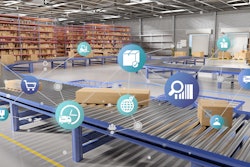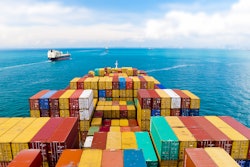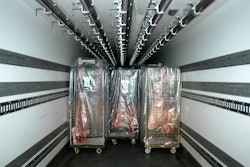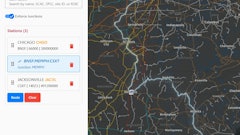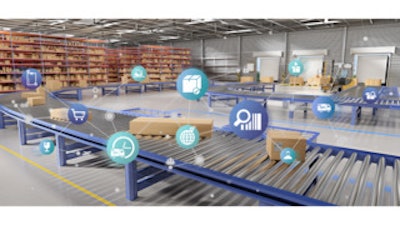
When 2021 hit, the world was ready for the New Year. Even if it brought with it a New Normal -- new way of doing business, a new way to shop for groceries and more -- the turning of the calendar meant putting a year of supply chain disruptions, restaurant closures and constant pivoting behind us.
But, then, on March 23, a stranded Evergreen container ship blocked navigation in Egypt’s Suez Canal, setting the stage for what would be a slew of supply chain disruptions after supply chain disruptions.
Suddenly, 2021 was quickly becoming a mirrored reflection of the year prior.
Then came the ransomware attacks, internet outages, container ships stuck at bay, bridge closures, driver shortages, ingredient shortages, natural disasters and more.
The hits just kept on hitting.
And, industry experts are already showing signs of struggle for 2022 into 2023, as routes to import/export remain clogged, ports continue to be backed up, cost of doing business increases and the labor shortage exists.
That’s because supply chains are messy. And, they’re only going to get worse before they get better.
In Food Logistics’ Nov/Dec 2021 issue, editor-in-chief Marina Mayer talks with several industry experts about the state of the supply chain and what’s in store for 2022.
Here’s an interview with Brian Numainville, principal, The Feedback Group, outlines why companies should implement technology that provides a high degree of supply chain visibility, with excerpts publishing in Food Logistics’ Nov/Dec 2021 issue. [CLICK HERE to read the article in full].
Food Logistics: 2021 started off with supply chain disruption after supply chain disruption. From the Suez Canal blockage and natural disasters to ransomware attacks and an industry-wide labor shortage, the supply chain industry is having to prove its resiliency over and over again. Looking into 2022, what does the state of the supply chain look like?
Brian Numainville: Supply chain challenges will continue to be an issue throughout 2022, as the pipeline of imports received via ships and railways remains clogged, truck drivers are in short supply, home-bound consumers purchased more items for at home use and production facilities remain labor challenged. And, we are again seeing limits placed on products in retail stores as rolling shortages are expected to continue. It’s definitely going to continue to be bad before it gets better.
Food Logistics: The cold food chain continues to face a host of risk/security challenges. What can companies be doing now to adapt for the future?
Numainville: With the impact of all of the facets of the pandemic on the cold food chain, it is critical that companies continue to plan, innovate and iterate with the worst-case scenarios in mind. This includes a wide range of activities, including improving standards and procedures, developing complete transparency into all of elements of the supply chain, moving more procurement to local sources and developing backup plans for both supply partners and personnel shortages.
Food Logistics: In terms of transportation, what are some of the trends you’re seeing for 2022? How do emerging technologies like blockchain, Internet of Things, cloud-based, etc. play a role in the evolution of transportation in the cold food chain?
Numainville: Holistic integration of technology, like blockchain, along with product sensors and QR codes allows complete traceability of the product throughout the supply chain. Not only does this assist with recalls, which is a great benefit in terms of both locating impacted product and eliminating waste from non-impacted product, [but] it also provides an audit trail for consumers to know their product was handled from grower to shipper to store. Then, using AI and big data, it is possible to make more accurate predictions for the future.
Food Logistics: Let’s talk supply chain visibility. What is your company – or what should companies – be doing to improve their own supply chain visibility?
Numainville: I think one of the most important things that companies should be doing is evaluating and implementing technology that provides a high degree of visibility into the supply chain. The pandemic really pushed all of us in new ways, and catapulted technology forward on many fronts. Embrace it.
Food Logistics: The labor shortage is a real thing, and it’s impacting several facets of the supply chain. What is your company – or what should companies – be doing to hire, onboard and retain good quality supply chain workers?
Numainville: The pandemic has had a clear and unmistakable impact on the labor force, with many opting to change careers or retire if they are able. Workplace safety, increased wages and flexibility are now tablestakes for workers as they look at their options. There are several things companies should be doing in the hiring process – online interviewing and recruiting is a must, for example, with quick turnaround from interview to hire. There are so many companies looking for workers that if you aren’t easy to navigate in the hiring process, the candidate will go elsewhere quickly. Same applies for the onboarding process – it needs to be efficient, easy to navigate and integrate. As far as retention, flexibility and clear communication of what you are doing to ensure safety are key. Overall, companies need to tell a clear and compelling story about why they are the place to work.
Food Logistics: The COVID-19 pandemic put extra emphasis on food safety and worker safety. What is the state of food safety and worker safety going into the New Year?
Numainville: Workplace sanitation and cleanliness was a fundamental that went into play quickly for worker safety. That has now migrated into vaccination and testing. As this flows through the system, I would expect things to stabilize throughout next year on this front.
Numainville: When it comes to grocery retail shopping and/or foodservice establishments, what are some trends you see sticking around post-pandemic, and which ways of doing business will somewhat go away?
Numainville: One of the things that will return are people shopping in stores. Our Grocery Shopper Intention Monitor earlier this year found four times as many shoppers plan to shop more often in a store as those who plan to shop less. At the same time, online shopping has jumped forward quickly and two times as many shoppers indicate they will shop more online versus less. The online expected shopping ratio is strongest among urban shoppers and Millennials.
Our research since the pandemic began clearly indicates shoppers continue to keep more product on hand than they did before the pandemic, across a number of supermarket categories. I expect this will continue as long as the supply chain is stressed.
Many retailers are also looking at how automation, using robotics and other technology can be used to help address labor challenges and inventory management, as well as delivery of food. This will accelerate into the New Year.
[CLICK HERE to read the article in full].





